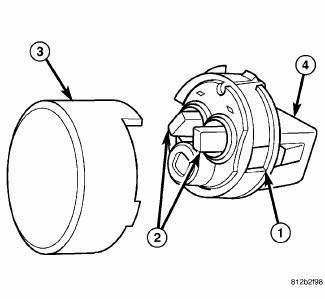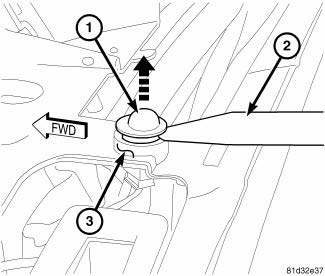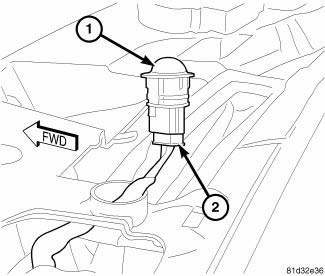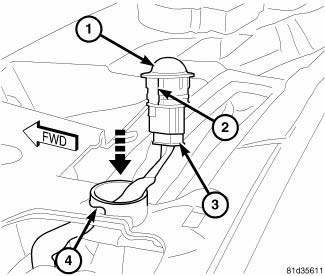Dodge Journey: Sensor, sun
DESCRIPTION

Fig. 40: Sensor-Sun
NOTE: Typical sun sensor assembly shown.
The automatic temperature control (ATC) heating-A/C system uses a sun sensor assembly (1) to measure sun light intensity. The sun sensor assembly incorporates two sun sensors (2) within a molded plastic case which is mounted to the instrument panel and a clear lens (3) that protrudes through the defroster grille. The wire harness receptacle (4) connects the sun sensors to the vehicle electrical system through a wire lead and connector of the instrument panel wire harness.
OPERATION
The ATC dual-zone heating-A/C system uses two sun sensors to balance the system in response to side-to-side variations in sun light intensity. Passengers in sun and shadow require different functional settings because they experience very different temperatures. The sun sensor assembly provides data to the A/C heater control to help determine proper mode and blend-air door positions and blower motor speeds. The sun sensors are not thermistor type sensors, but rather photo diodes. For this reason the sun sensors responds to sun light intensity rather than temperature. The sun sensor assembly is also used to sense day and night conditions for automatic headlight control, if equipped.
The sun sensor is diagnosed using a scan tool. The sun sensor assembly cannot be adjusted or repaired and must be replaced if inoperative or damaged.
Diagnosis and Testing
SUN SENSOR
WARNING: Disable the airbag system before attempting any steering wheel, steering column, or instrument panel component diagnosis or service. Disconnect and isolate the negative battery (ground) cable, then wait two minutes for the airbag system capacitor to discharge before performing further diagnosis or service. This is the only sure way to disable the airbag system. Failure to take the proper precautions may result in an accidental airbag deployment and possible serious or fatal injury.
The sun sensor assembly is located so that the sun rays will hit the sensors in the same way that it will hit the driver and the passenger. It is important that the area in front of the sun sensor assembly be unobstructed. Check for the following:
- Windshield wipers are properly adjusted.
- Defroster grille or sun sensor is properly installed. The sun sensor lens should protrude above the defroster grille.
- Any stickers on the windshield are not directly in front of the sun sensor.
- Any items laying on top of the instrument panel are not covering the sun sensor.
If the vehicle exhibits a lack of passenger comfort in sunny weather such as in the early afternoon, inspect the position of the sun sensor assembly. The sun sensor lens should protrude above the defroster grille to insure proper operation. If the sun sensor is not properly positioned, perform the following procedure:
1. Confirm that the defroster grille is properly installed. If not, repair as required.
2. Remove the defroster grille and verify that the sun sensor is properly installed to the instrument panel.
3. Reinstall the defroster grille.
The A/C-heater control continually monitors the sun sensor circuits and will store diagnostic trouble codes (DTCs) for any problem it detects. The sun sensor can be tested in the vehicle with a scan tool.
REMOVAL
WARNING: Disable the airbag system before attempting any steering wheel, steering column or instrument panel component diagnosis or service. Disconnect and isolate the negative battery (ground) cable, then wait two minutes for the airbag system capacitor to discharge before performing further diagnosis or service. This is the only sure way to disable the airbag system. Failure to follow these instructions may result in accidental airbag deployment and possible serious or fatal injury.

Fig. 41: Sun Sensor Remove
1. Disconnect and isolate the negative battery cable.
2. Remove the defroster grille.
3. Using Trim Stick C-4755 or equivalent (2), gently pry between both sides of the sun sensor assembly (1) and the instrument panel (3) to release the snap retainers that secure the sun sensor.

Fig. 42: Sun Sensor Wire Connector
4. Disconnect the wire harness connector (2) from the sun sensor assembly (1) and remove the sensor.
INSTALLATION

Fig. 43: Sun Sensor Install
1. Position the sun sensor assembly (1) to the top of the instrument panel (4) and connect the wire harness connector (3).
2. Align the tab (2) on the sun sensor assembly with the opening in the instrument panel.
3. Gently push the sun sensor assembly into the instrument panel until the sensor snap retainers are securely engaged.
4. Install the defroster grille.
5. Reconnect the negative battery cable.
 Sensor, infrared temperature
Sensor, infrared temperature
DESCRIPTION
Fig. 37: Infrared Sensor
The infrared temperature sensor is located in the overhead console and
consists of an infrared transducer
concealed behind a clear lens (2) in a molded plas ...
 Transducer, A/C pressure
Transducer, A/C pressure
DESCRIPTION
Fig. 44: A/C Pressure Transducer
- A/C PRESSURE TRANSDUCER
The A/C pressure transducer (1) is a switch that is installed on a fitting
located on the A/C liquid line at the righ ...
See also:
Removal, Installation
REMOVAL
REMOVAL - NGC CONTROLLER
Fig. 39: Remove/Install PCM
NOTE: USE THE SCAN TOOL TO REPROGRAM THE NEW POWERTRAIN CONTROL
MODULE (PCM) WITH THE VEHICLES ORIGINAL IDENTIFICATION NUMBER
( ...
MIRRORS
Inside Day/Night Mirror
A two-point pivot system allows for horizontal and
vertical mirror adjustment. Adjust the mirror to center on
the view through the rear window.
Headlight glare can be reduc ...
Removal
CLUTCH - FIXED DISPLACEMENT A/C COMPRESSOR
WARNING: Refer to the applicable warnings and cautions for this
system before
performing the following operation. Failure to follow the warnin ...
